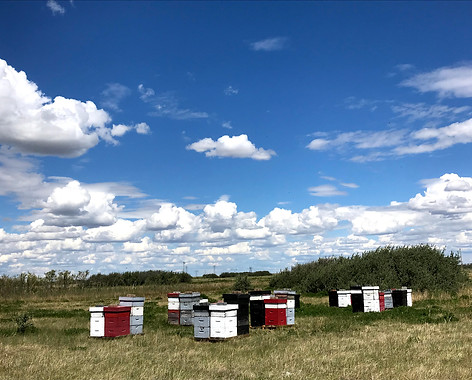MASTERS THESIS
Chapters of my thesis work are currently in the process of publication. See the Publications page for further publications information.
With funding from the Rangeland Research Institute, we designed a thesis project that investigated the effects of managed pollinators (honey bees) on native plant-pollinator network interactions in southern Alberta.
ABSTRACT:
The grasslands region of southern Alberta, Canada, is dominated by agricultural activity, and approximately 75% of native grasslands have been lost to development. Honey bees (Apis mellifera) were introduced about a century ago, and today they are used to facilitate the pollination of crops; in one season, the region supports approximately 3.15 billion individuals. These super-generalists have been known in other places to compete with native pollinators, and may contribute to the decline of wild pollinator diversity and richness. Mounting evidence has also suggested that honey bees may alter the structure and function of plant-pollinator network interactions in a wild pollinator community, which may affect its resilience to perturbations and persistence into the future.
This study examined the effects of honey bee abundance on native grassland pollinator communities by experimentally introducing honey bee hives to grasslands at the U. of A. Rangeland Research Institute’s Mattheis Research Ranch in southern Alberta, where pollinator abundance and diversity and plant-pollinator interactions over two summer seasons were sampled. Eighteen transects, at distances of 100 m, 500 m, and 5000 m from three clusters of honey bee hives, were established and floral insect visitors at each transect were sampled almost weekly. Flower species and flower visitors were then identified, and their interactions were compiled into plant-pollinator networks, from which species abundance, diversity, species composition, and network metrics related to network stability, structure, and resource use overlap, were analyzed. My findings indicate that honey bees did not affect wild pollinator abundance, richness, diversity, or species composition. Instead, flower species richness generally explained the variation in pollinator abundance, richness, and diversity. Additionally, honey bees impacted network structure by decreasing interaction evenness, and affected resource use overlap by increasing plant and pollinator functional complementarity. However, these network iii structural changes were due mostly to the added honey bee-plant interactions, and not to honey bees causing changes in how native pollinators interacted with plants.
This study demonstrates that honey bees may not negatively impact native plant-pollinator communities in all contexts, and that, despite influencing interaction network structure and floral resource use, they may not affect the diversity of wild insect pollinators or their interactions with plants. Although caution should be used in generalizing these results in other regions, evidence suggests that honey bees are not a major threat to the wild pollinators in this area, at least in regard to changes to their diversity or interactions.
.jpg)
Network diagram created from preliminary network data. The upper row of boxes represents pollinator groups (Order, or other, such as "Wasps"), and the bottom row, in black, represents floral species. Each line depicts an interaction, and the width of the line indicates the density of interactions between a pollinator group and a plant species. Network diagrams, visualized as such, can give insight into specialists and generalists within a community.

Some of the many specimens identfied throughout my thesis work. All pollinator groups (flies, butterflies, bees, wasps, ants, beetles, etc) were identified.

One of the experimentally introduced honey bee hive locations. Transects were sampled at varying distances from these hives to assess the effect of honey bees on the native plant-pollinator networks.

